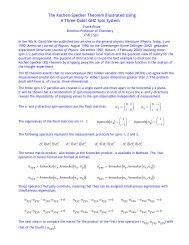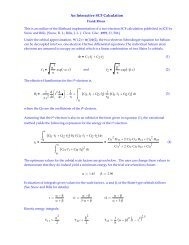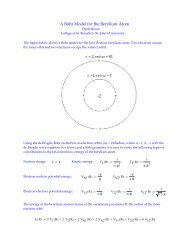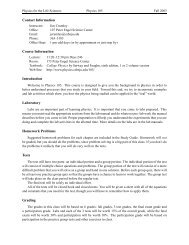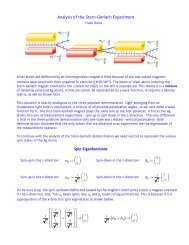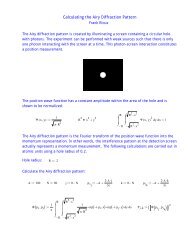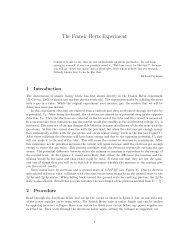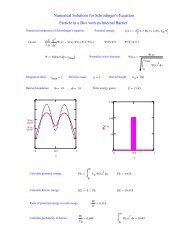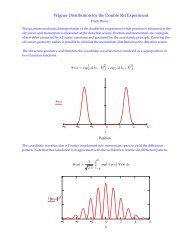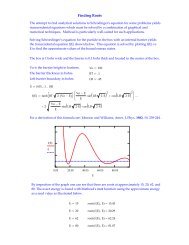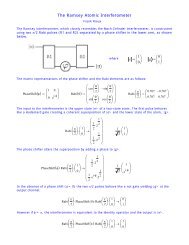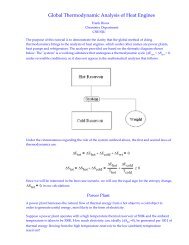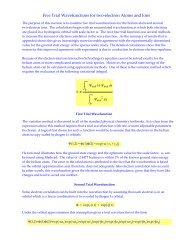A Fortran program to calculate sunrise and sunset - Users.csbsju.edu
A Fortran program to calculate sunrise and sunset - Users.csbsju.edu
A Fortran program to calculate sunrise and sunset - Users.csbsju.edu
- No tags were found...
Create successful ePaper yourself
Turn your PDF publications into a flip-book with our unique Google optimized e-Paper software.
5 Corrections for atmospheric effectsThe Earth’s atmosphere can cause the apparent time of rising or setting <strong>to</strong> differby a few minutes from the actual time or rising. If the vertical displacement is x(which accounts for both the sun’s finite angular diameter, horizontal parallax,<strong>and</strong> atmospheric refraction), then the time correction iswhere<strong>and</strong>∆t = 240y seconds, (10)cos δ( ) sin xy = sin −1 degrees (11)sin ψ( ) sin φψ = cos −1 degrees. (12)sin δThe Sun’s angular diameter is 0 ◦ .533, its horizontal parallax is 8.79 arcseconds,<strong>and</strong> the atmosphere contributes 34 minutes of arc of refraction, sox = 0◦ .5332+ 8 ′′ .79 + 34 ′ . (13)For this calculation, δ is the average declination for the two days for which theSun’s position was <strong>calculate</strong>d.Once ∆t has been found, it can be converted <strong>to</strong> seconds <strong>and</strong> added <strong>to</strong> T s <strong>and</strong>subtracted from T r .6 Final stepsT r <strong>and</strong> T s at this stage are LST times. In order <strong>to</strong> convert them <strong>to</strong> local civiltimes, they first need <strong>to</strong> be converted <strong>to</strong> GST times. The GST times are thenconverted <strong>to</strong> GMT times. Finally, the time zone offset is applied <strong>to</strong> the GMTtimes, resulting in the local civil times for <strong>sunrise</strong> <strong>and</strong> <strong>sunset</strong>.7 TestingTo see whether the output of my <strong>program</strong> was any good, I compared its <strong>calculate</strong>dtimes <strong>to</strong> times <strong>calculate</strong>d by the U.S. Naval Observa<strong>to</strong>ry, using a web format http://aa.usno.navy.mil/data/docs/RS OneDay.html. I compared timesfor several dates for an observer in Avon, MN (45.6 ◦ N, 94.5 ◦ W) as seen in thetable below:5
Date USNO T r Program T r USNO T s Program T s01 January 1980 07h 58m 07h 55m 16h 44m 16h 40m24 August 1980 06h 30m 06h 28m 20h 10m 20h 09m07 September 1980 06h 47m 06h 45m 19h 44m 19h 43m01 January 2007 07h 59m 07h 55m 16h 45m 16h 40m24 August 2007 06h 29m 06h 27m 20h 11m 20h 10m07 September 2007 06h 46m 06h 45m 19h 45m 19h 44m8 ConclusionThe results from the <strong>Fortran</strong> <strong>program</strong> seem reasonably accurate; the times itpredicts are within five minutes of the times predicted by the USNO. The resultsmatch exactly those which were given by the book for an observer on 7 September1979 at longitude 0 ◦ , 52 ◦ N.BibliographyDuffett-Smith, Peter. Practical astronomy with your calcula<strong>to</strong>r. Second Edition.Cambridge, 1981.6



